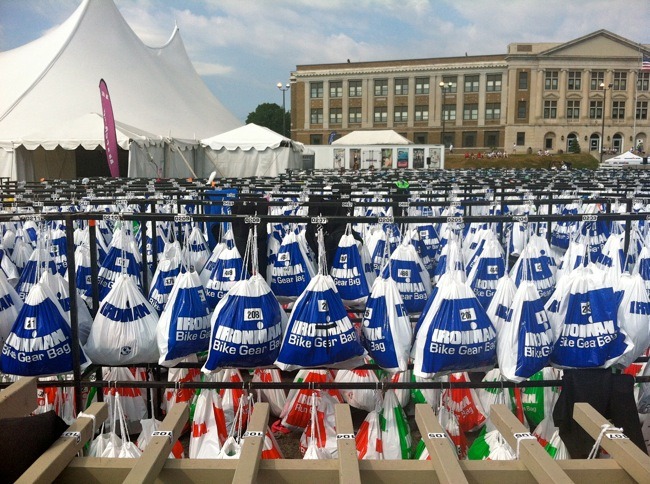
Did you know that after months and months of training, blood sweat, and tears, and thousands of dollars invested in equipment and travel to your race, you’re most likely to trash it all in the first 30 miles of the bike and 8 miles of the run?
In this post I’ll explain why and what actions you can take to not ruin your race.
Why?
Internal and External Disconnects
These initial segments of the bike and run are characterized by “internal and external disconnects” that make it very difficult to recognize the fact that you’re about to ruin your race:
- Internal Disconnects: basically, your heart rate, how hard you think you’re working (Rate of Perceived Exertion), and how hard you actually are working (as measured by power or pace) are usually completely out of sync for about the first 30-45 minutes of the bike and the first 3-6 miles of the run. That is, it may feel easy, your heart rate may be telling you that your effort is manageable, but if we were to look at your power or pace, we’d see that your effort is much higher than it should be.
- External Disconnects: at the same time, everyone else around you has this same internal disconnect, and the net is that you’re surrounded by many, many athletes riding too hard or running too fast. It can be very difficult to not do what everyone else is doing, which is hammering the bike and run in the first 3rd of each leg.
What to Do?
- Recognize and gain confidence from the other 90%: in our experience, 90% of the Ironman field doesn’t know how to race, and so racing well is mostly about doing the opposite of everyone else, pretty much all day! This is nowhere more true than in the first 3rd of the bike and run legs. Rather than do what everyone else is doing, tell yourself “they are doing the wrong thing, I’m doing the right thing. I becoming more confident in my race as I witness hundreds of athletes doing everything they can to ruin their race before it really even begins! I’m going to have a good day!”
- Give yourself a heart rate ceiling and power/pace caps for the first portions of the bike and run: If I told you right now we’re going for very easy spin on the bike or a light jog, you have heart rates and wattage/paces identified for these “go all day” efforts. We want you to get your heart rate down to that level in the first 3rd of the bike and run, using these wattage and power caps to help get you there. You are truly, the real sense of the word, simply warming up before you start to actually ride your bike or run. Yes, we want you to go that easy.Finally, understand that we are only in control of our pace for the first about 6-8 miles of the run. This is the only portion of the run in which we can usually chose to run faster. Beyond 8 miles the run is increasingly about just doing the best you can as the run becomes more and more difficult. The purpose of our guidance here to run very easily, at a warmup pace for the first six miles, is then about getting you through this very risky portion of the run, where everyone else is running much, much too fast.
- Flatten the hills on the bike: this is how we teach our athletes to ride hills on an Ironman bike course —
- Entrance: as you approach a hill and the road begins to go up while your cadence and speed begin to decrease, (1) pay attention to the pressure on the soles of your feet and your cadence, then downshift quickly through the gears maintaining this same on-the-flats pedal pressure and cadence at the entrance to the hill. At the same time (2) watch the other athletes around you and observe they are NOT doing this, with the result that they instantly gap you by 2-5 bike length. Don’t worry, they are working to hard and you are not!
- Body of the Hill: as you run out of gears and are now just getting up the hill, ask yourself “what is effort I should be climb up this hill, given that I still have to ride X miles and then run a marathon!” When you frame the question that way, it’s pretty clear that it’s not about how quickly you get up this but rather what is the correct effort to set up the marathon. And the answer is…comfortably!
- Crest: as your begin to reach the top of the hill and your cadence and speed increases (1) do our pedal pressure and cadence drill again, this time upshifting quickly the gears, maintaining your climbing effort across the crest and into the downhill. At the same time (2) observe the athletes around you and notice their body language. They will likely shut it down at the crest and immediately begin to coast. More importantly observe how little real estate they’ve gained on you despite their massive effort at the entrance and in the body of the climb.
- Downhill: keep pedaling and only coast when your speed is about 33-34mph. Very important: this speed on the downhill sets up your speed across the next flat into the next hill and the next. Always be thinking “Conservation of Momentum” and keep your speed rolling across the course through the intelligent and steady application of power in the hills.
In Summary
As you begin the bike and run legs of your next Ironman, understand that these are the riskiest parts of your day. Follow our guidance by using this time to warmup and don’t be dumb, while at the same time making sure you’re doing the opposite of everyone else.
Explore the Team

Leave a Reply